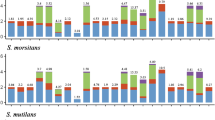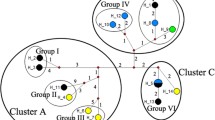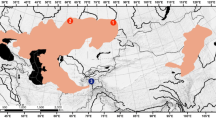Abstract
Background
Tandem repeats in mitochondrial DNA control region are known to different animal taxa, including bat species of the family Vespertilionidae. The long R1-repeats in the bat ETAS-domain are often presented in a variable copy number and may exhibit both inter-individual and intra-individual sequence diversity. The function of repeats in the control region is still unclear, but it has been shown that repetitive sequences in some animal groups (shrews, cats and sheep) may include parts of ETAS1 and ETAS2 conservative blocks of mitochondrial DNA.
Methods and results
Analysis of the control region sequences for 31 Myotis petax specimens allowed the identification of the inter-individual variability and clarification of the composition of the R1-repeats. The copy number of the R1-repeats varies from 4 to 7 in individuals. The specimens examined do not exhibit a size heteroplasmy previously described for Myotis species. The unusual short 30 bp R1-repeats have been detected in M. petax for the first time. The ten specimens from Amur Region and Primorsky Territory have one or two copies of these additional repeats.
Conclusions
It was determined that the R1-repeats in M. petax control region consist of parts of the ETAS1 and ETAS2 blocks. The origin of the additional repeats seems to be related to the 51 bp deletion in the central part of the R1-repeat unit and subsequent duplication. Comparison of repetitive sequences in the control region of closely-related Myotis species identified the occurrence of incomplete repeats also resulting from the short deletions, but distinct from additional repeats of M. petax.



Similar content being viewed by others
Data availability
The datasets generated and analysed during the current study are available in the GenBank repository.
Change history
08 September 2023
A Correction to this paper has been published: https://doi.org/10.1007/s11033-023-08750-5
References
Brown GG, Gadaleta G, Pepe G, Saccone C, Sbisà E (1986) Structural conservation and variation in the D-loop-containing region of vertebrate mitochondrial DNA. J Mol Biol 192(3):503–511. https://doi.org/10.1016/0022-2836(86)90272-X
Gemmell NJ, Western PS, Watson JM, Graves JA (1996) Evolution of the mammalian mitochondrial control region—comparisons of control region sequences between monotreme and therian mammals. Mol Biol Evol 13(6):798–808. https://doi.org/10.1093/oxfordjournals.molbev.a025640
Saccone C, Pesole G, Sbisá E (1991) The main regulatory region of mammalian mitochondrial DNA: structure-function model and evolutionary pattern. J Mol Evol 33(1):83–91. https://doi.org/10.1007/BF02100199
Yamagata T, Namikawa T (1999) Sequence variation and evolution of the mitochondrial DNA control region in the musk shrew Suncus murinus. Genes Genet Syst 74(5):257–266. https://doi.org/10.1266/ggs.74.257
Sbisà E, Tanzariello F, Reyes A, Pesole G, Saccone C (1997) Mammalian mitochondrial D-loop region structural analysis: identification of new conserved sequences and their functional and evolutionary implications. Gene 205(1–2):125–140. https://doi.org/10.1016/S0378-1119(97)00404-6
Sun K, Feng J, Jin L, Liu Y, Shi L, Jiang T (2009) Structure, DNA sequence variation and phylogenetic implications of the mitochondrial control region in horseshoe bats. Mamm Biol 74(2):130–144. https://doi.org/10.1016/j.mambio.2008.09.002
Larizza A, Pesole G, Reyes A, Sbisà E, Saccone C (2002) Lineage specificity of the evolutionary dynamics of the mtDNA D-loop region in rodents. J Mol Evol 54(2):145–155. https://doi.org/10.1007/s00239-001-0063-4
Mao X, Dong J, Hua P, He G, Zhang S, Rossiter SJ (2014) Heteroplasmy and ancient translocation of mitochondrial DNA to the nucleus in the Chinese Horseshoe Bat (Rhinolophus sinicus) complex. PLoS ONE 9(5):e98035. https://doi.org/10.1371/journal.pone.0098035
Sun K, Luo L, Zhang Z, Liu S, Feng J (2013) Molecular characteristics and evolution of the mitochondrial control region in three genera (Hipposideridae: Hipposideros, Aselliscus and Coelops) of leaf-nosed bats. Mitochondrial DNA 24(4):451–461. https://doi.org/10.3109/19401736.2013.766176
Rahman MM, Yoon KB, Park YC (2019) Structural characteristics of a mitochondrial control region from Myotis bat (Vespertilionidae) mitogenomes based on sequence datasets. Data Brief 24:103830. https://doi.org/10.1016/j.dib.2019.103830
Anderson S, Bankier A, Barrell B, de Bruijn MHL, Coulson AR, Drouin J, Eperon IC, Roe BA, Nierlich DP, Sanger F, Schreier PH, Smith AJH, Staden R, Young IG (1981) Sequence and organization of the human mitochondrial genome. Nature 290:457–465. https://doi.org/10.1038/290457a0
Dufresne C, Mignotte F, Guéride M (1996) The presence of tandem repeats and the initiation of replication in rabbit mitochondrial DNA. Eur J Biochem 235(3):593–600. https://doi.org/10.1111/j.1432-1033.1996.00593.x
Wilkinson GS, Mayer F, Kerth G, Petri B (1997) Evolution of repeated sequence arrays in the D–loop region of bat mitochondrial DNA. Genetics 146(3):1035–1048. https://doi.org/10.5167/uzh-423
Liu F, Song Y, Yan S, Luo J, Jiang F (2009) Structure and sequence variation of the mitochondrial DNA control region in Myotis macrodactylus. Chin J Zool 44:19–27
Buroker NE, Brown JR, Gilbert TA, O’Hara PJ, Beckenbach AT, Thomas WK, Smith MJ (1990) Length heteroplasmy of sturgeon mitochondrial DNA: an illegitimate elongation model. Genetics 124(1):157–163. https://doi.org/10.1093/genetics/124.1.157
Kaur T, Ong AH (2011) Heteroplasmy, length, and sequence characterization of the mitochondrial control region in Tomistoma schlegelii. Biochem Genet 49(9–10):562–575. https://doi.org/10.1007/s10528-011-9431-y
Lunt DH, Whipple LE, Hyman BC (1998) Mitochondrial DNA variable number tandem repeats (VNTRs): utility and problems in molecular ecology. Mol Ecol 7(11):1441–1455. https://doi.org/10.1046/j.1365-294x.1998.00495.x
Mayer F, Kerth G (2005) Microsatellite evolution in the mitochondrial genome of Bechstein’s bat (Myotis bechsteinii). J Mol Evol 61(3):408–416. https://doi.org/10.1007/s00239-005-0040-4
Ray DA, Densmore LD (2003) Repetitive sequences in the crocodilian mitochondrial control region: poly-A sequences and heteroplasmic tandem repeats. Mol Biol Evol 20(6):1006–1013. https://doi.org/10.1093/molbev/msg117
Yue GH, Liew WC, Orban L (2006) The complete mitochondrial genome of a basal teleost, the Asian arowana (Scleropages formosus, Osteoglossidae). BMC Genomics 7:242. https://doi.org/10.1186/1471-2164-7-242
Mundy NI, Helbig AJ (2004) Origin and evolution of tandem repeats in the mitochondrial DNA control region of shrikes (Lanius spp.). J Mol Evol 59(2):250–257. https://doi.org/10.1007/s00239-004-2619-6
An J, Okumura H, Lee YS, Kim KS, Min MS, Lee H (2010) Organization and variation of the mitochondrial DNA control region in five Caprinae species. Genet Genom 32:335–344. https://doi.org/10.1007/s13258-010-0023-8
Ba H, Wu L, Liu Z, Li C (2016) An examination of the origin and evolution of additional tandem repeats in the mitochondrial DNA control region of Japanese sika deer (Cervus nippon). Mitochondrial DNA Part A 27(1):276–281. https://doi.org/10.3109/19401736.2014.892077
Douzery EJ, Randi E (1997) The mitochondrial control region of Cervidae: evolutionary patterns and phylogenetic content. Mol Biol Evol 14(11):1154–1166. https://doi.org/10.1093/oxfordjournals.molbev.a025725
Freeman AR, MacHugh DE, McKeown S, Walzer C, McConnell DJ, Bradley DG (2001) Sequence variation in the mitochondrial DNA control region of wild African cheetahs (Acinonyx jubatus). Heredity 86:355–362. https://doi.org/10.1046/j.1365-2540.2001.00840.x
Fumagalli L, Taberlet P, Favre L, Hausser J (1996) Origin and evolution of homologous repeated sequences in the mitochondrial DNA control region of shrews. Mol Biol Evol 13(1):31–46. https://doi.org/10.1093/oxfordjournals.molbev.a025568
Hoelzel AR, Hancock JM, Dover GA (1991) Evolution of the cetacean mitochondrial D-loop region. Mol Biol Evol 8(4):475–493. https://doi.org/10.1093/oxfordjournals.molbev.a040662
Hoelzel AR, Lopez JV, Dover GA, O’Brien SJ (1994) Rapid evolution of a heteroplasmic repetitive sequence in the mitochondrial DNA control region of carnivores. J Mol Evol 39(2):191–199. https://doi.org/10.1007/BF00163807
Matson CW, Baker RJ (2001) DNA sequence variation in the mitochondrial control region of red-backed voles (Clethrionomys). Mol Biol Evol 18(8):1494–1501. https://doi.org/10.1093/oxfordjournals.molbev.a003935
Merker S, Thomas S, Völker E, Perwitasari-Farajallah D, Feldmeyer B, Streit B, Pfenninger M (2014) Control region length dynamics potentially drives amino acid evolution in tarsier mitochondrial genomes. J Mol Evol 79(1–2):40–51. https://doi.org/10.1007/s00239-005-0040-4
Mignotte F, Gueride M, Champagne AM, Mounolou JC (1990) Direct repeats in the non-coding region of rabbit mitochondrial DNA. Involvement in the generation of intra- and inter-individual heterogeneity. Eur J Biochem 194(2):561–571. https://doi.org/10.1111/j.1432-1033.1990.tb15653.x
Stewart DT, Baker AJ (1994) Patterns of sequence variation in the mitochondrial D-loop region of shrews. Mol Biol Evol 11(1):9–21. https://doi.org/10.1093/oxfordjournals.molbev.a040096
Jebb D, Foley NM, Whelan CV, Touzalin F, Puechmaille SJ, Teeling EC (2018) Population level mitogenomics of long-lived bats reveals dynamic heteroplasmy and challenges the free radical theory of ageing. Sci Rep 8(1):13634. https://doi.org/10.1038/s41598-018-31093-2
Kerth G, Mayer F, König B (2000) Mitochondrial DNA (mtDNA) reveals that female Bechstein’s bats live in closed societies. Mol Ecol 9(6):793–800. https://doi.org/10.1046/j.1365-294x.2000.00934.x
Petri B, von Haeseler A, Pääbo S (1996) Extreme sequence heteroplasmy in bat mitochondrial DNA. Bio Chem Hoppe-Seyler 377(10):661–667. https://doi.org/10.1515/bchm3.1996.377.10.661
Wilkinson GS, Chapman AM (1991) Length and sequence variation in evening bat D-loop mtDNA. Genetics 128(3):607–617. https://doi.org/10.1093/genetics/128.3.607
Aljanabi S, Martinez I (1997) Universal and rapid salt-extraction of high quality genomic DNA for PCR-based techniques. Nucleic Acids Res 25:4692–4693. https://doi.org/10.1093/nar/25.22.4692
Ye J, Coulouris G, Zaretskaya I, Cutcutache I, Rozen S, Madden TL (2012) Primer-BLAST: a tool to design target-specific primers for polymerase chain reaction. BMC Bioinformatics 13:134. https://doi.org/10.1186/1471-2105-13-134
Kibbe WA (2007) OligoCalc: an online oligonucleotide properties calculator. Nucleic Acids Res 35(Web Server issue):W43–W46. https://doi.org/10.1093/nar/gkm234
Katoh K, Misawa K, Kuma K, Miyata T (2002) MAFFT: a novel method for rapid multiple sequence alignment based on fast Fourier transform. Nucleic Acids Res 30(14):3059–3066. https://doi.org/10.1093/nar/gkf436
Zuker M, Stiegler P (1981) Optimal computer folding of large RNA sequences using thermodynamics and auxiliary information. Nucleic Acids Res 9(1):133–148. https://doi.org/10.1093/nar/9.1.133
SantaLucia J Jr (1998) A unified view of polymer, dumbbell, and oligonucleotide DNA nearest-neighbor thermodynamics. Proc Natl Acad Sci USA 95(4):1460–1465. https://doi.org/10.1073/pnas.95.4.1460
Zuker M (2003) Mfold web server for nucleic acid folding and hybridization prediction. Nucleic Acids Res 31(13):3406–3415. https://doi.org/10.1093/nar/gkg595
Ruedi M, Stadelmann B, Gager Y, Douzery EJP, Francis CM, Lin LK, Guillén-Servent A, Cibois A (2013) Molecular phylogenetic reconstructions identify East Asia as the cradle for the evolution of the cosmopolitan genus Myotis (Mammalia, Chiroptera). Mol Phylogenet Evol 69:437–449. https://doi.org/10.1016/j.ympev.2013.08.011
Ruedi M, Csorba G, Lin LK, Chou CH (2015) Molecular phylogeny and morphological revision of Myotis bats (Chiroptera: Vespertilionidae) from Taiwan and adjacent China. Zootaxa 3920(1):301–342. https://doi.org/10.11646/zootaxa.3920.2.6
Acknowledgements
We wish to express sincere gratitude to the Dr I.V. Kartavtseva for help in collecting and analysing the material. We are especially grateful to the members of Vladivostok Caving Club, to O.N. Morozov from the Geological and Speleological Club "Dolgan", to S.Yu. Ignatenko and E.V. Ignatenko from the Zeya Nature Reserve and to employees of Komsomolsk Nature Reserve for the organisation of field works.
Funding
This work was supported by RFBR according to the research project No. 18-34-00285 and by RSF according to the research project No. 22-24-00017. The research was carried out within the state assignment of Ministry of Science and Higher Education of the Russian Federation (Theme No. 121031500274-4).
Author information
Authors and Affiliations
Contributions
All authors contributed to the study conception and design. Material preparation, data collection and analysis were performed by UVG, DVK and VYG. The first draft of the manuscript was written by UVG and INS commented on previous versions of the manuscript. All authors read and approved the final manuscript.
Corresponding author
Ethics declarations
Conflict of interest
The authors have no relevant financial or non-financial interests to disclose.
Ethical approval
All applicable international, national and institutional ethics statements when using animals in research have been followed. Approval was granted by the Commission for the Regulation of Experimental Research (Bioethics Commissions) of Federal Scientific Center of the East Asia Terrestrial Biodiversity (Date 25.04.2022/No. 1).
Additional information
Publisher's Note
Springer Nature remains neutral with regard to jurisdictional claims in published maps and institutional affiliations.
The original online version of this article was revised: In Table 1, the coordinates "43°17.133' N 133°36.800' E" is corrected as "43°16.200' N 133°37.200' E" and the coordinates "54°28.488′ N 113° 47.703′" is corrected as "54°26.400' N 113°46.800' E". In the acknowledgments section, the names "S.Yu. Ignateko and E.V. Igantenko” are corrected as "S.Yu. Ignatenko and E.V. Ignatenko".
Supplementary Information
Below is the link to the electronic supplementary material.
Rights and permissions
Springer Nature or its licensor (e.g. a society or other partner) holds exclusive rights to this article under a publishing agreement with the author(s) or other rightsholder(s); author self-archiving of the accepted manuscript version of this article is solely governed by the terms of such publishing agreement and applicable law.
About this article
Cite this article
Gorobeyko, U.V., Sheremetyeva, I.N., Kazakov, D.V. et al. A new type of tandem repeats in Myotis petax (Chiroptera, Vespertilionidae) mitochondrial control region. Mol Biol Rep 50, 5137–5146 (2023). https://doi.org/10.1007/s11033-023-08468-4
Received:
Accepted:
Published:
Issue Date:
DOI: https://doi.org/10.1007/s11033-023-08468-4




